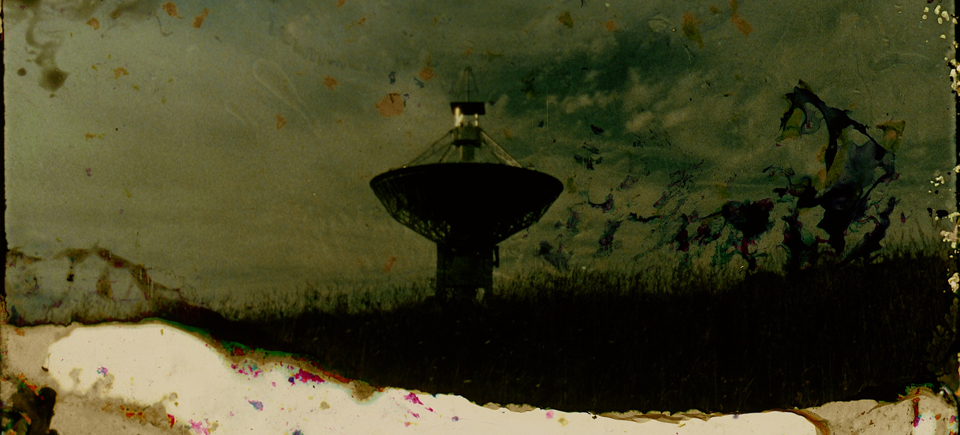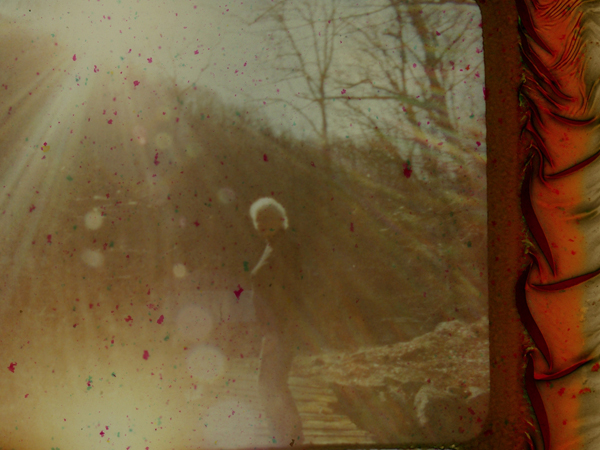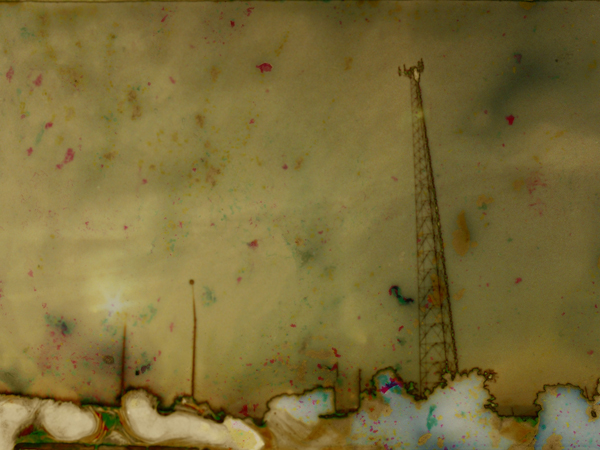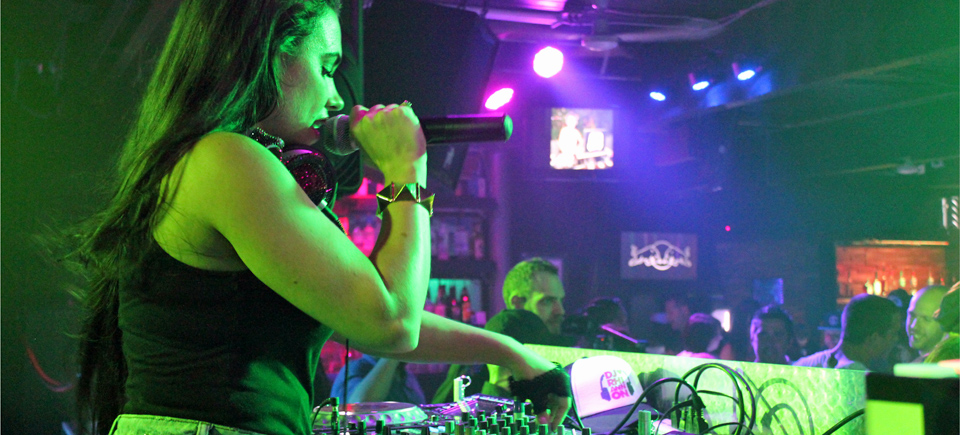
Quiet Zone | 3 Questions with Musician/Filmmaker David Bryant (Godspeed You! Black Emperor)
Quiet Zone | 3 Questions with Musician/Filmmaker David Bryant (Godspeed You! Black Emperor)
Is it possible the modern world, crisscrossed as it is with wifi and cellphone signals of all sorts, is making some of us sick?
This is the question filmmakers Karl Lemieux and David Bryant set out to explore and illustrate in Quiet Zone, an experimental doc that takes us deep into the daily lives of those who suffer from electromagnetic hypersensitivity (EHS.)
Quiet Zone, David Bryant & Karl Lemieux, provided by the National Film Board of Canada
The film, 14-minutes in length, follows some of these “wave refugees” who have settled in West Virginia around the Green Bank observatory, in an electromagnetic radiation-free area known as the National Radio Quiet Zone.
Through an alternative processing technique known as mordançage, the film creates the impression of electromagnetic radiation through film, making the distress of these “refugees” palpable.

Musician, recordist and sound designer David Bryant is known for his role in the bands Godspeed You! Black Emperor, Hiss Tracts and Set Fire to Flames. In 2004, he built The Pines Recording Studio, where he has produced the music and sound design for Madame Tutli-Putli (Chris Lavis and Maciek Szczerbowski, 2007) and Passage (Karl Lemieux, 2007).
Quiet Zone is his directorial debut, about which he gracefully answered some of our questions.
NFB: What is the most useful or interesting thing you learned or experienced as a composer/sound artist making a foray into filmmaking?
David Bryant: …it didn’t feel like much of a shift, translating how I have worked in the past, into making a film that typically positions image over sound…and the intention in the beginning was that Karl and I would never favour one over the other…we were interested in this collision of sound and image right from the start…we were curious to see how far we could push that…
…I have been into gathering sound for as long as I can remember…recording fragments of shortwave radio when I was a kid…later on, carrying a tape recorder around wherever I went…street recordings mostly…voices…stories…I started making radio documentaries, not just because I couldn’t afford film, but because I liked that action of creating the visual component in my head…we all do it…in the act of listening, we are always marrying some sort of visual representation/landscape to the sound …for years I have incorporated street recordings and spoken text into the music I make…movies without pictures…I made a couple of records under the name Set Fire to Flames, and obsessively edited those as though I was editing a film…always thinking visually…but enjoying the freedom of not being restricted by a particular sequence of filmed images…working on Quiet Zone didn’t feel all that different to working on those Set Fire to Flames records…in the chemical process that Karl used to manipulate the film, he somehow created this hallucination of abstractions that always seemed to shift…that was somehow never fixed…and teleporting the sound of voices, frequencies and ultimately a narrative into the middle of that abstraction felt completely natural…
NFB: What surprised or moved you the most about the illness discussed in the film, electromagnetic hypersensitivity?
…the fragility of people living in forced isolation…often in complete desperation, with very few options available to them…
…electromagnetic hypersensitivity (EHS) debilitates people who have a pathological intolerance to electromagnetic fields…to certain frequency bands in the electromagnetic spectrum that cell phone towers and wi-fi signals occupy…EHS is a fairly controversial diagnosis, and is not currently recognized as a legitimate illness by most parts of the medical/scientific community…personally, at the start, it was never all that important to me whether or not I actually believed EHS to be genuine…Karl and I never set out to prove or disprove anything…that wasn’t the kind of film we were making…I went in with an open mind for sure…and immediately felt a crushing sadness and empathy for those women cloistered in the hills of West Virginia who were clearly suffering…I saw these women not unlike the canary in the coal mine…and felt that the rampant acceleration of technological gadgetry impacting our lives and our desire to embrace it without question or pause was potentially dangerous… but I also saw the National Radio Quiet Zone as some sort of parallel or alternate universe…a burnt-out science fiction movie set…like a J.G. Ballard novel or an extension of Tarkovsky’s Stalker landscape…there is such a crazy confluence of energies colliding in this part of West Virginia…a strange magnetism in those mountains…there is the National Radio Astronomy Observatory with their radio telescopes mapping the solar system and looking for signs of extra-terrestrial life…there is also a secret military installation called Sugar Grove…they have radio telescopes as well as an underground surveillance bunker where the NSA is based out of…in the 1960s Sugar Grove was used to monitor Soviet radar and radio signals that were bouncing off the moon…currently, this is where they listen to everyone’s cell phone conversations…

…as I got to know these women more, the harder it was for me to remove myself, emotionally…and I am now left with very little doubt about the legitimacy of EHS as an illness…so much of what I experienced in those mountains makes it impossible for me to discount it…as human beings, we all have certain sensitivities…some of us are deathly allergic to peanuts and exposure to them can be fatal…if we can propose, even as an idea, that some people have sensitivities to certain parts of the electromagnetic spectrum that make them physically and psychically ill, then what options remain for those sufferers trying to find a safe place to live?…the sad reality is that the National Radio Quiet Zone is not truly quiet…cell phone signals irradiate every corner of the planet…and the presence of those frequencies will continue to grow exponentially with more and more towers being built…as a result, EHS sufferers have been forced into some sort of nomadic existence…on an endless and ultimately futile search for a place where they can live freely/healthily in this world…and those places are becoming harder to find…I think this is what breaks my heart the most…the annihilation and disappearance of landscapes that are truly wild and free…
NFB: What’s next for you and Karl?
David Bryant:…hatching plans for another documentary…
*
More:
Watch Quiet Zone
Discover a playlist of David Bryant’s top NFB films
-
Pingback: quiet zone - Set Fire to Flames
-
Pingback: Hiss Tracts › Quiet Zone #3

